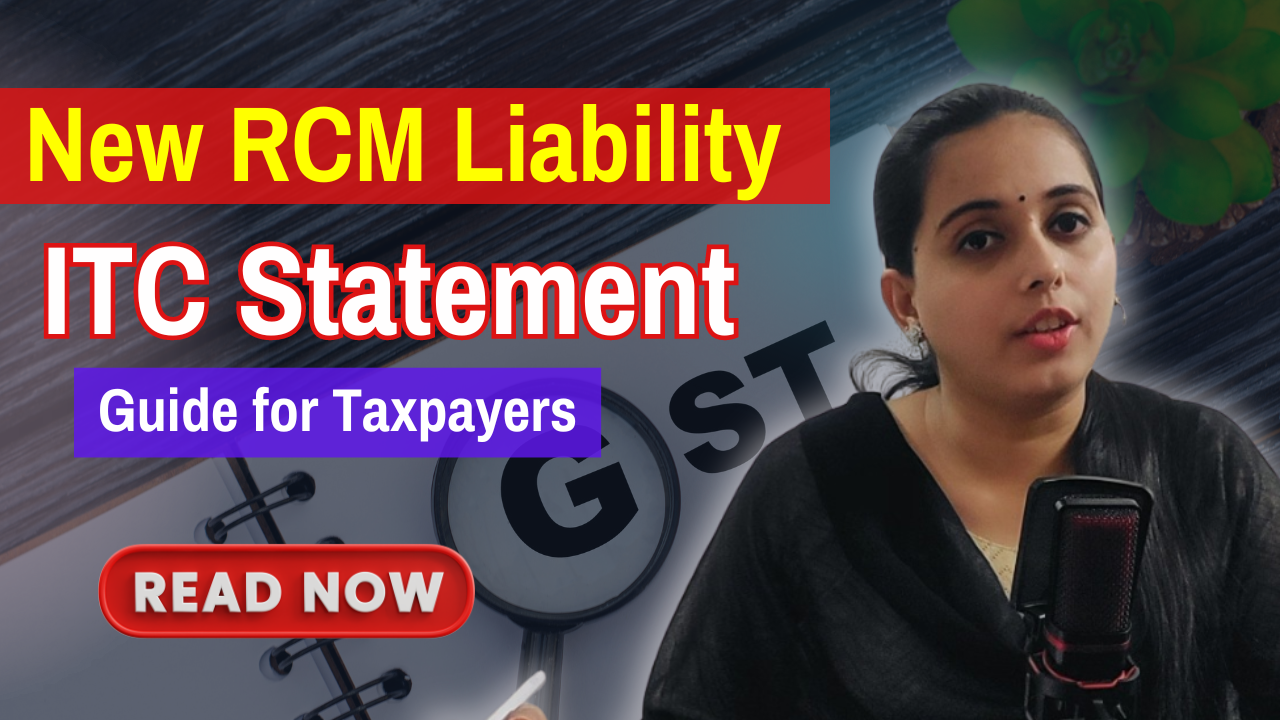Introduction to the New RCM Liability
Introduction to the New RCM Liability The GST portal has introduced a new tool to simplify and enhance the transparency of Reverse Charge Mechanism (RCM) transactions – the RCM Liability/ITC Statement. This tool, effective from August 2024 for monthly filers and the July-September 2024 period for quarterly filers, helps taxpayers accurately report their RCM liabilities and corresponding Input Tax Credit (ITC) claims. In this blog, we’ll guide you through the significance of the new statement, how it works, and the key actions taxpayers need to take.
What is the RCM Liability/ITC Statement?
Introduction to the New RCM Liability The RCM Liability/ITC Statement is a new feature on the GST portal designed to capture the RCM liability declared in Table 3.1(d) of GSTR-3B and its corresponding ITC claimed in Tables 4A(2) and 4A(3) for a given return period. It provides a comprehensive overview of RCM-related transactions, making it easier for taxpayers to track both their liabilities and the credits they are eligible to claim. This step is expected to reduce errors and discrepancies, ensuring greater compliance with GST rules.
How to Access the RCM Liability/ITC Statement?
Taxpayers can access the new RCM Liability/ITC Statement on the GST portal through the following navigation:
- Login to the GST Portal
- Go to Services >> Ledger >> RCM Liability/ITC Statement
This simple navigation will bring you to the statement, where you can report and track your RCM liabilities and ITC claims.
Reporting the RCM ITC Opening Balance
Introduction to the New RCM Liability To ensure accurate tracking of past RCM transactions, taxpayers are required to report their RCM ITC opening balance. Here’s a step-by-step guide on how to do it:
- Login to the GST portal.
- Navigate to Report RCM ITC Opening Balance or use the path Services >> Ledger >> RCM Liability/ITC Statement >> Report RCM ITC Opening Balance.
Key Scenarios for Reporting RCM ITC Opening Balance
- Excess RCM Liabilities Paid but Not Claimed as ITC
If a taxpayer has paid excess RCM liabilities (reported in Table 3.1(d) of GSTR-3B) but has not claimed the corresponding ITC (in Tables 4A(2) or 4A(3) of GSTR-3B), they need to report the positive value of the excess paid as their RCM ITC opening balance.
- Excess ITC Claimed but Not Paid as RCM Liabilities
Introduction to the New RCM Liability If a taxpayer has claimed excess ITC (in Tables 4A(2) or 4A(3) but has not declared the corresponding liability in Table 3.1(d) of GSTR-3B, they must report the negative value of the excess claimed as their RCM ITC opening balance.
- Reclaiming Reversed RCM ITC
In cases where RCM ITC was reversed in earlier tax periods (through Table 4(B)2 of GSTR-3B) and is now eligible for reclaim, the taxpayer can reclaim it via Table 4A(5) of GSTR-3B. However, note that this ITC should not be reported as part of the opening balance in the RCM ITC Statement.
Important Deadlines for Reporting RCM ITC Opening Balance
Taxpayers must carefully report their opening balance in the RCM ITC Statement before the following deadlines:
– Monthly Filers: Report the opening balance up to the July 2024 return period.
– Quarterly Filers: Report the opening balance up to Q1 of FY 2024-25 (i.e., the April-June 2024 return period).
Deadline for Declaring Opening Balance
The opening balance must be declared by October 31, 2024 . It’s crucial to ensure all past RCM liabilities and ITC are accurately reconciled before this date to avoid penalties or discrepancies.
Amendments in the Opening Balance
If a taxpayer discovers any errors while declaring their opening balance, they will be allowed to amend it up to November 30, 2024. Each taxpayer will be provided with three opportunities to rectify any errors in their opening balance. After this date, the amendment facility will be discontinued.
Conclusion
The introduction of the RCM Liability/ITC Statement on the GST portal is a welcome step toward increasing the accuracy and transparency of RCM transactions. It ensures taxpayers have a clearer view of their liabilities and ITC claims, minimizing errors and enhancing compliance with GST rules.
Be sure to report your RCM ITC opening balance correctly and adhere to the deadlines to avoid complications. For more updates on compliance, taxation, and GST-related topics, stay tuned to our blog.
FAQs
- When is the RCM Liability/ITC Statement applicable from?
The statement is applicable from August 2024 for monthly filers and July-September 2024 for quarterly filers.
- What is the deadline for reporting the RCM ITC opening balance?
The deadline for reporting the opening balance is October 31, 2024.
- How can I amend my RCM ITC opening balance if I make an error?
Taxpayers can amend their opening balance up to November 30, 2024, with three opportunities to correct any mistakes.
Stay compliant, and remember to reconcile your RCM transactions for a hassle-free tax filing experience!
For more tips and the latest updates on GST, RCM, and ITC, subscribe to our newsletter or check out our latest videos on our YouTube channel.
https://youtu.be/FJVcWLPC5A8?si=IY4B84pU2X6LUrnI
For More Information : https://taxgyany.com/

